Enhancing Productivity and Resource Conservation by Eliminating Inefficiency of Thai Rice Farmers: A Zero Inefficiency Stochastic Frontier Approach
Abstract
:1. Introduction
Challenges Facing the Thai Rice Economy
2. Methodology
2.1. The Zero Inefficiency Stochastic Frontier Model (ZISFM)
2.2. Estimation of Farm-Specific Inefficiency and Technical Efficiency
2.3. The Data
2.4. The Empirical Model
3. Empirical Results
3.1. Technical Efficiency Distribution and Their Determinants
3.2. Scenarios of Potential Production Increase and Resource Conservation
4. Conclusions
Acknowledgments
Author Contributions
Conflicts of Interest
References
- Ajewole, O.C.; Folayan, J.A. Stochastic frontier analysis of technical efficiency in dry season leaf vegetable production among smallholders in Ekiti state, Nigeria. Agric. J. 2008, 3, 252–257. [Google Scholar]
- Bravo-Ureta, B.E.; Rieger, L. Dairy Farm Efficiency Measurement Using Stochastic Frontiers and Neoclassical Duality. Am. J. Agric. Econ. 1991, 73, 421–428. [Google Scholar] [CrossRef]
- Afriat, S.N. Efficiency estimation of production functions. Int. Econ. Rev. 1972, 13, 568–598. [Google Scholar] [CrossRef]
- Mishra, A.; Kumar, P.; Noble, A. Assessing the potential of SRI management principles and the FFS approach in Northeast Thailand for sustainable rice intensification in the context of climate change. Int. J. Agric. Sustain. 2013, 11, 4–22. [Google Scholar] [CrossRef]
- Petchseechoung, W. Rice Industry. Thailand Industry Outlook; Krungsri Research: Bangkok, Thailand, 2016. [Google Scholar]
- Arunmas, P.; Ruangdit, P. US Report Puts Thai Rice Edge in Doubt; Bangkok Post: Bangkok, Thailand, 2012. [Google Scholar]
- John, A. Price Relations between Export and Domestic Rice Markets in Thailand. Food Policy 2013, 42, 48–57. [Google Scholar] [CrossRef]
- Mahanaseth, I.; Tauer, L.W. Thailand’s Market Power in Its Rice Export Markets. J. Agric. Food Ind. Organ. 2014, 12, 109–120. [Google Scholar] [CrossRef]
- IRRI. How to Manage Water? Rice Knowledge Bank, IRRI: Los Banos, The Philippines, 2002; Available online: http://www.knowledgebank.irri.org/step-by-step-production/growth/water-management (accessed on 20 March 2017).
- Thaiturapaisan, T. Drought, a Worrying Situation for Thai Agriculture. 2015. Available online: https://www.scbeic.com/en/detail/product/1429 (accessed on 9 March 2017).
- OECD. Economic Outlook for Southeast Asia, China and India 2014: Beyond the Middle-Income Trap. 2013. Available online: http://dx.doi.org/10.1787/saeo-2014-en (accessed on 14 March 2017).
- Tirado, R.; Englande, A.J.; Promakasikorn, L; Novotny, V. Use of Agrochemicals in Thailand and Its Consequences for the Environment. Greenpeace Research Laboratories Technical Note. 2008. Available online: http://www.greenpeace.to/publications/GPSEA_agrochemical-use-in-thailand.pdf (accessed on 3 March 2017).
- Franco, N. Thailand’s Rice Industry is in Crisis during a Politically Sensitive Period. 2016. Available online: https://www.linkedin.com/pulse/rice-market-news-17112016-negri-franco?articleId=8612683279200132720 (accessed on 17 March 2017).
- Hariraksapitak, P.; Tanakasempipat, P. Thailand Offers $1 Billion Loan to Struggling Jasmine Rice Farmers; Thomson Reuters: New York, NY, USA, 2016. [Google Scholar]
- Blake, C.; Suwannakij, S. Thai Junta Flip-Flop on Populism Too Late for Suffering Farmers. 2016. Available online: https://www.bloomberg.com/news/articles/2016-11-22/thai-junta-flip-flop-on-populism-too-late-for-suffering-farmers (accessed on 12 March 2017).
- Tsionas, E.G. Combining DEA and stochastic frontier models: An empirical Bayes approach. Eur. J. Oper. Res. 2003, 147, 499–510. [Google Scholar] [CrossRef]
- Coelli, T.J. Recent Development in Frontier Modeling and Efficiency Measurement. Aust. J. Agric. Econ. 1995, 39, 219–245. [Google Scholar] [CrossRef]
- Aigner, D.J.; Lovell, C.A.K.; Schmidt, P. Formulation and estimation of Stochastic Frontier Production function models. J. Econ. 1977, 6, 21–37. [Google Scholar] [CrossRef]
- Meeusen, W.; Broeck, V.D. Efficiency estimation from Cobb-Douglas production function with composed error. Int. Econ. Rev. 1977, 18, 435–455. [Google Scholar] [CrossRef]
- Chen, Z.; Song, S. Efficiency and technology gap in China’s agriculture: A regional meta-frontier analysis. China Econ. Rev. 2008, 19, 287–296. [Google Scholar] [CrossRef]
- Rahman, K.M.M.; Mia, M.I.A.; Bhuiyan, M.K.J. A Stochastic Frontier Approach to Model Technical Efficiency of Rice Farmers in Bangladesh: An Empirical Analysis. Agriculturists 2012, 10, 9–19. [Google Scholar] [CrossRef]
- Yang, Z.; Mugera, A.W.; Zhang, F. Investigating Yield Variability and Inefficiency in Rice Production: A Case Study in Central China. Sustainability 2016, 8, 787. [Google Scholar] [CrossRef]
- Kim, D.H.; Sambou, M.O.; Jung, M.S. Does Technology Transfer Help Small and Medium Companies? Empirical Evidence from Korea. Sustainability 2016, 8, 1119. [Google Scholar] [CrossRef]
- Avea, A.D.; Zhu, J.; Tian, X.; Baležentis, T.; Li, T.; Rickaille, M.; Funsani, W. Do NGOs and Development Agencies Contribute to Sustainability of Smallholder Soybean Farmers in Northern Ghana—A Stochastic Production Frontier Approach. Sustainability 2016, 8, 465. [Google Scholar] [CrossRef]
- Kumbhakar, S.C.; Parmeter, C.F.; Tsionas, E.G. A zero-inefficiency stochastic frontier model. J. Econ. 2013, 172, 66–76. [Google Scholar] [CrossRef]
- Tran, K.C.; Tsionas, M.G. Zero inefficiency stochastic frontier models with varying mixing proportion: A semiparametric approach. Eur. J. Oper. Res. 2016, 249, 1113–1123. [Google Scholar] [CrossRef]
- Coelli, T.J. Estimators and hypothesis tests for a stochastic frontier function: A Monte Carlo analysis. J. Product. Anal. 1995a, 6, 247–268. [Google Scholar] [CrossRef]
- Rho, S.; Schmidt, P. Are all firms inefficient? J. Product. Anal. 2015, 43, 327–349. [Google Scholar] [CrossRef]
- Parmeter, C.F.; Kumbhakar, S.C. Efficiency analysis: A primer on recent advances. Found. Trends Econ. 2014, 7, 191–385. [Google Scholar] [CrossRef]
- Jondrow, J.; Lovell, C.A.K.; Materov, I.S.; Schmidt, P. On the estimation of technical inefficiency in the stochastic frontier production function model. J. Econ. 1982, 19, 233–238. [Google Scholar] [CrossRef]
- Greene, W.H. A stochastic frontier model with correction for sample selection. J. Product. Anal. 2010, 34, 15–24. [Google Scholar] [CrossRef]
- Rahman, S.; Rahman, M. Impact of land fragmentation and resource ownership on productivity and efficiency: The case of rice producers in Bangladesh. Land Use Policy 2009a, 26, 95–103. [Google Scholar] [CrossRef]
- Rahman, S.; Wiboonpongse, A.; Sriboonchitta, S.; Chaovanapoonphol, Y. Production efficiency of Jasmine rice farmers in northern and northeastern Thailand. J. Agric. Econ. 2009b, 60, 419–435. [Google Scholar] [CrossRef]
- Sriboonchitta, S.; Liu, J.; Wiboonpongse, A.; Denoeux, T. A double-copula stochastic frontier model with dependent error components and correction for sample selection. Int. J. Approx. Reason. 2017, 80, 174–184. [Google Scholar] [CrossRef]
- Battese, G.; Coelli, T. A model for technical inefficiency effects in a stochastic frontier production function for panel data. Empir. Econ. 1995, 20, 325–332. [Google Scholar] [CrossRef]
- Battese, G.E.; Coelli, T.J. Frontier production functions, technical efficiency and panel data: With application to paddy farmers in India. J. Product. Anal. 1992, 3, 153–169. [Google Scholar] [CrossRef]
- Greene, W. Distinguishing between heterogeneity and inefficiency: Stochastic frontier analysis of the World Health Organization’s panel data on national health care systems. Health Econ. 2004, 13, 959–980. [Google Scholar] [CrossRef] [PubMed]
- Asante, B.O.; Villano, R.A.; Battese, G.E. The effect of the adoption of yam minisett technology on the technical efficiency of yam farmers in the forest-savanna transition zone of Ghana. Afr. J. Agric. Resour. Econ. 2014, 9, 75–90. [Google Scholar]
- Asadullah, M.N.; Rahman, S. Farm productivity and efficiency in rural Bangladesh: The role of education revisited. Appl. Econ. 2009, 41, 17–33. [Google Scholar] [CrossRef]
- Chen, A.Z.; Wallace, E.H.; Scott, R. Technical Efficiency of Chinese Grain Production: A Stochastic Production Frontier Approach. In Proceedings of the American Agricultural Economics Association Annual Meeting, Montreal, QC, Canada, 27 July 2003. [Google Scholar]
- Ahmad, M.; Chaudhry, G.M.; Iqbal, M. Wheat productivity, efficiency, and Sustainability: A stochastic production frontier analysis. Pak. Dev. Rev. 2002, 41, 643–663. [Google Scholar]
- Pandey, S.; Mortimer, M.; Wade, L.; Tuong, T.P.; Lopez, K.; Hardy, B. (Eds.) Direct seeding: Research issues and opportunities. In Proceedings of the International Workshop on Direct Seeding in Asian Rice Systems: Strategic Research Issues and Opportunities, Bangko, Thailand, 25–28 January 2000; International Rice Research Institute: Los Baños, Philippines, 2002. [Google Scholar]
- Nirmal, G. Thailand to Set Aside More Land for Farming; It Plans to Increase Rice Production and Stop Conversion of Agricultural Land; Straits Times: Singapore, 2008. [Google Scholar]
- Webb, S. Thailand Aims for 25 mln T Rice Paddy Output 2016–17, down on yr; Reuters Africa: Kenya, Africa, 2016. [Google Scholar]
- Ali, A.; Erenstein, O.; Rahut, D.B. Impact of direct rice sowing technology on rice producers’ earnings: Empirical evidence from Pakistan. Dev. Stud. Res. 2014, 1, 244–254. [Google Scholar] [CrossRef]
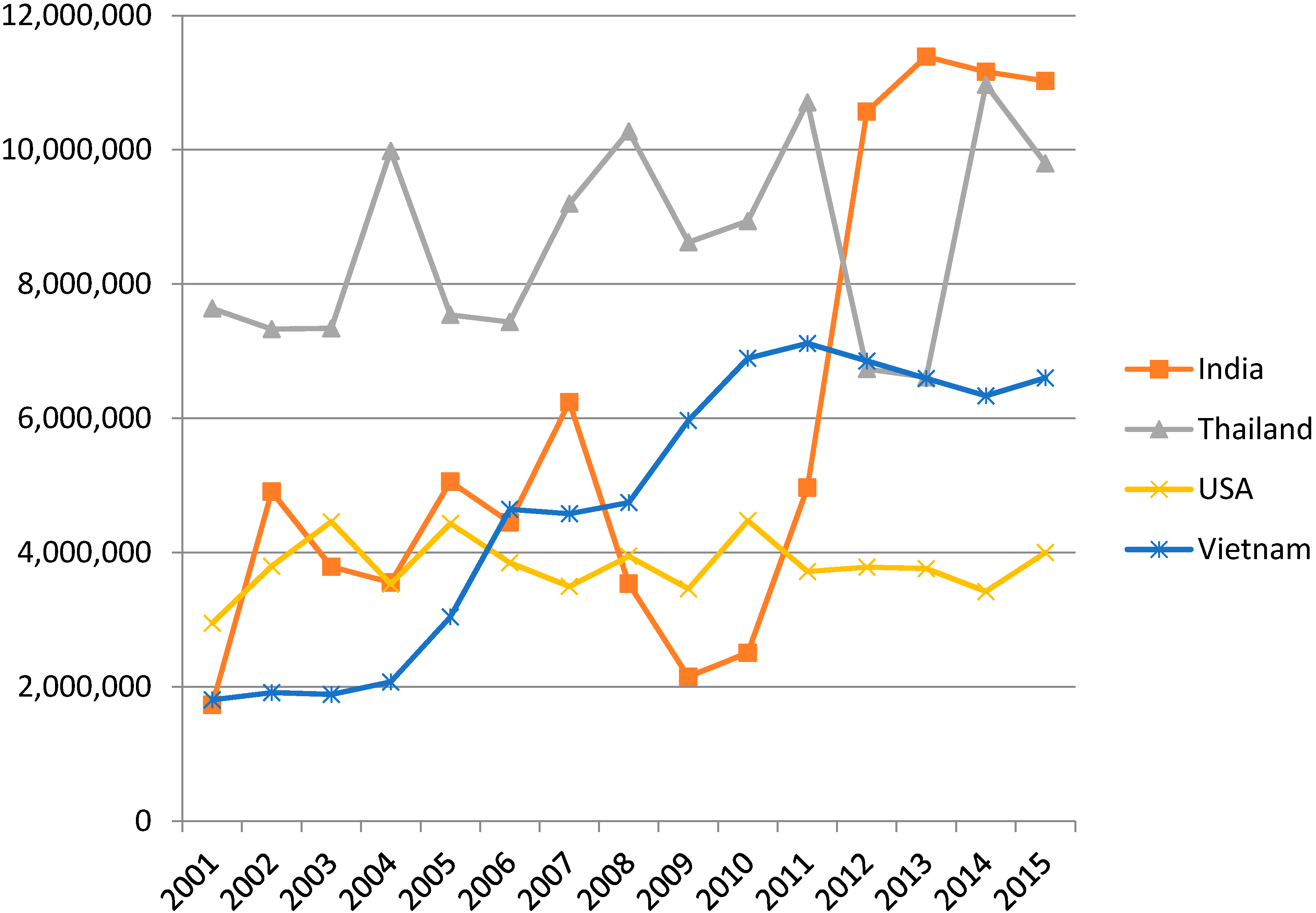
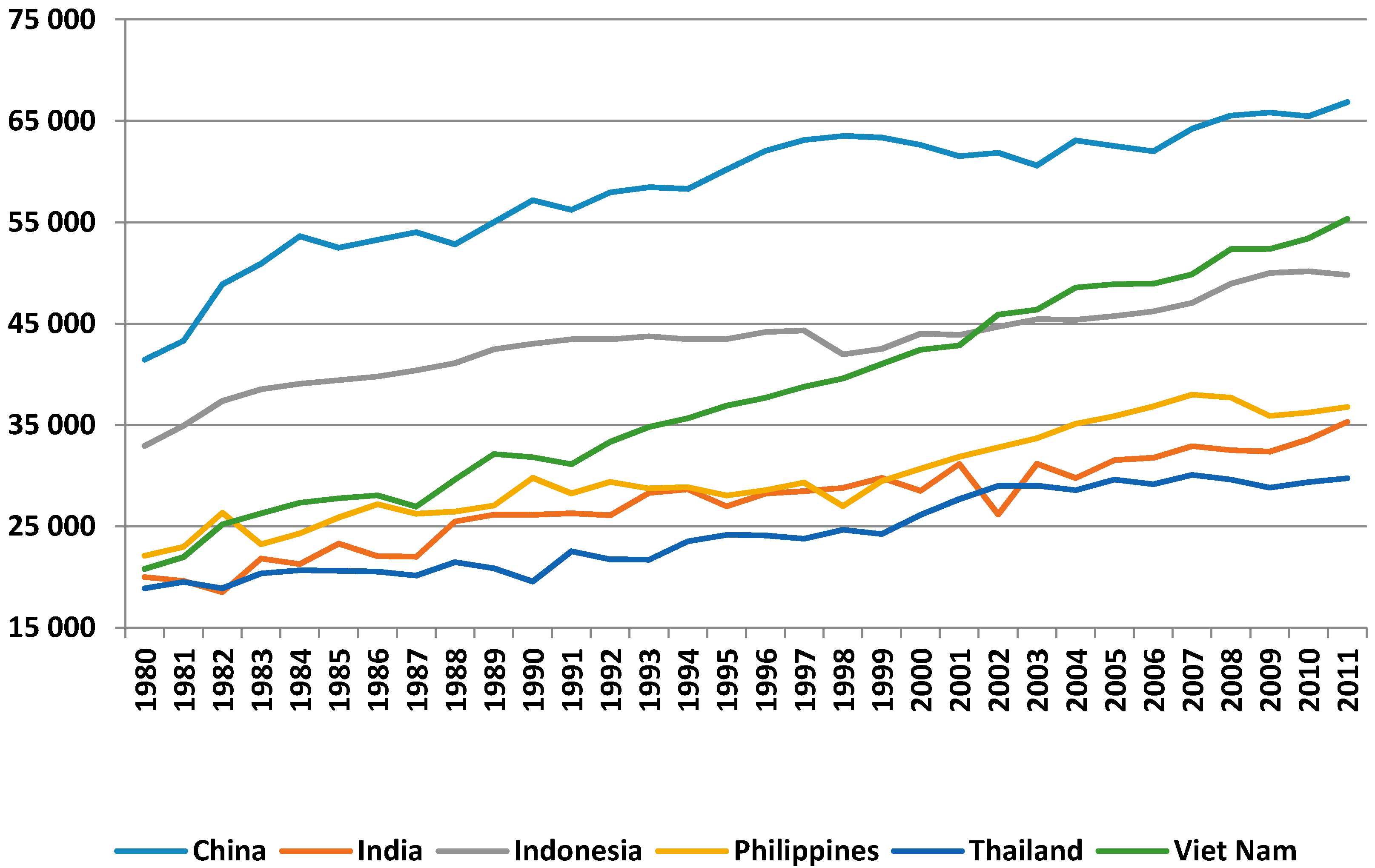
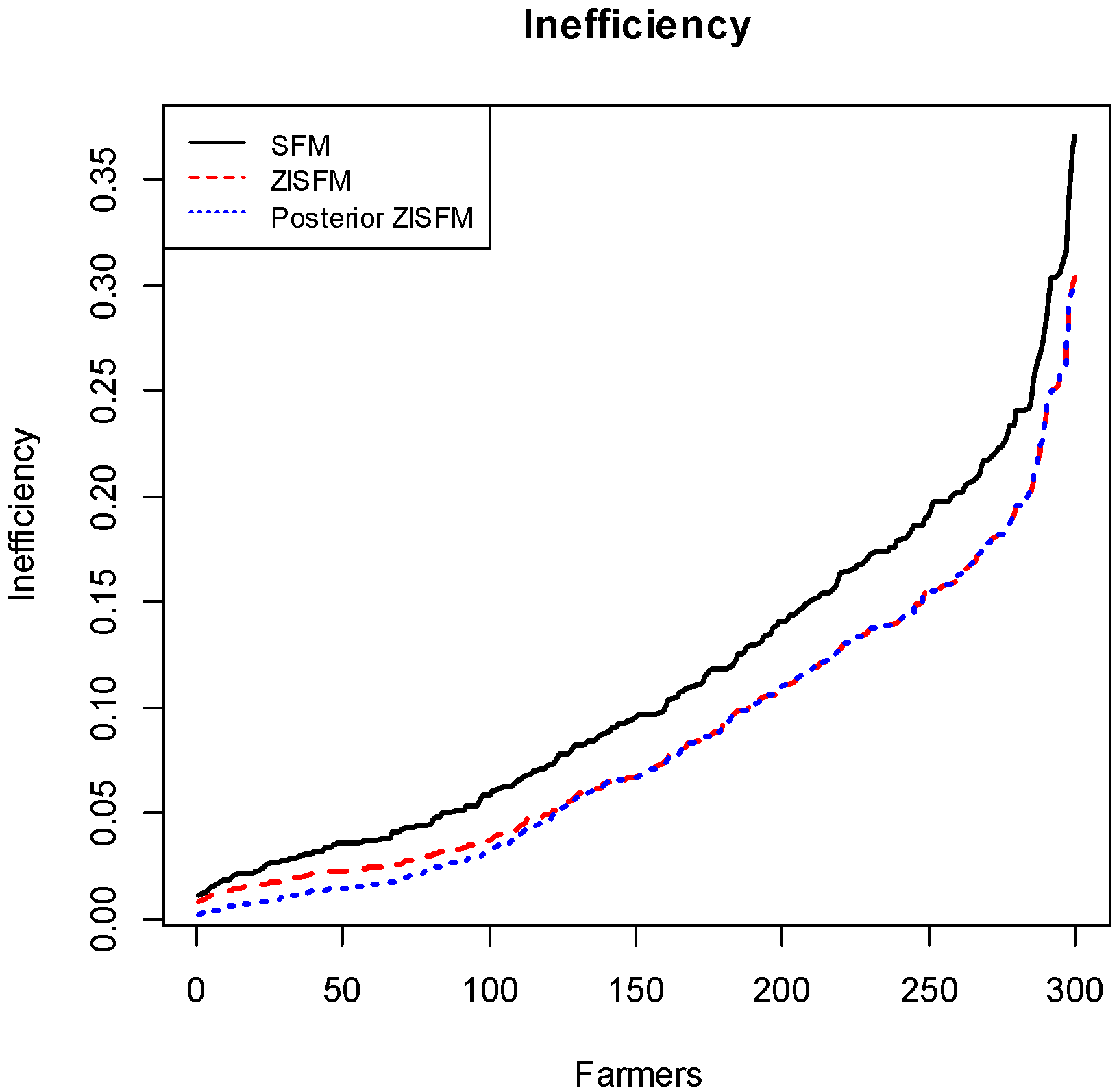
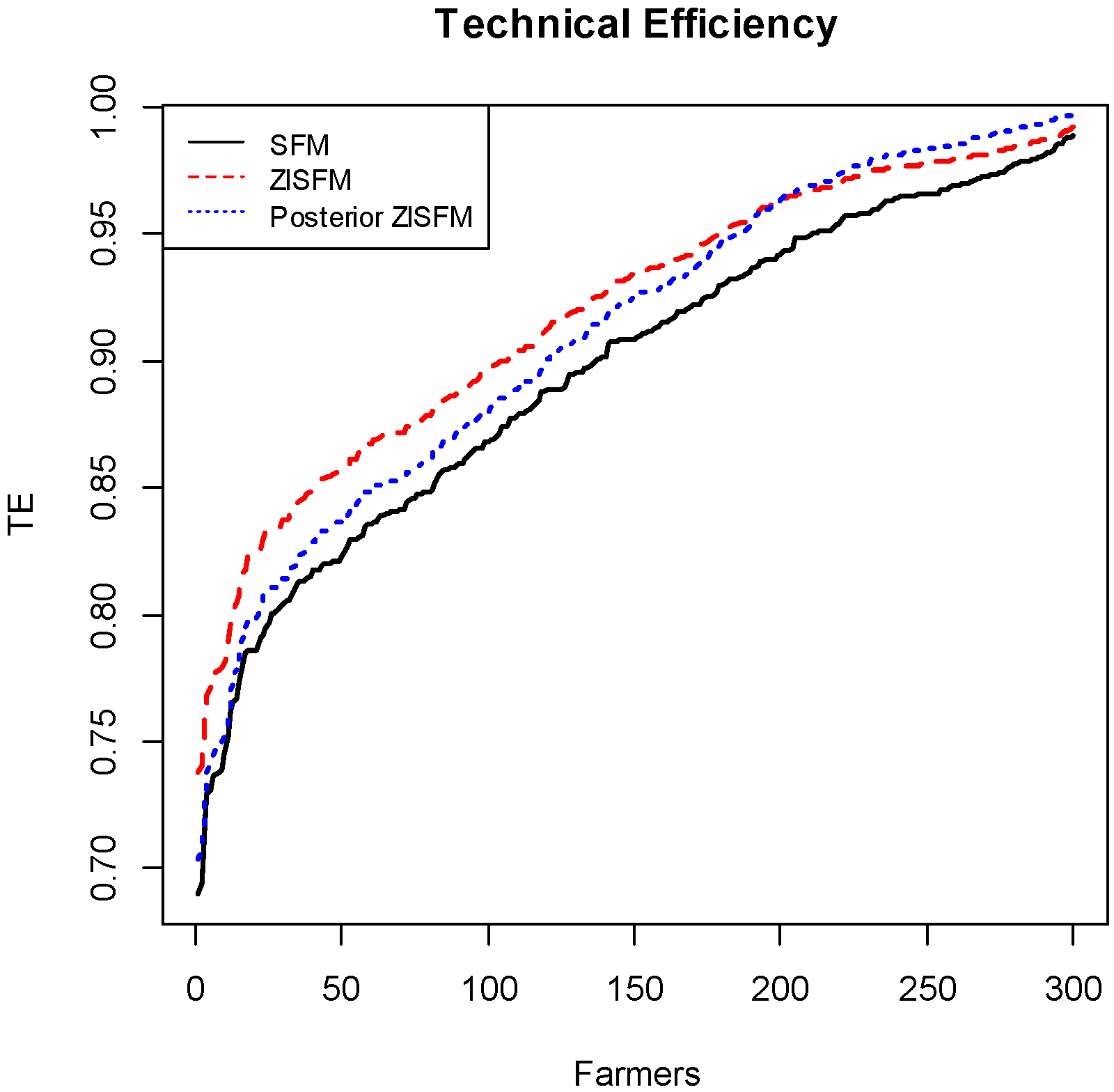
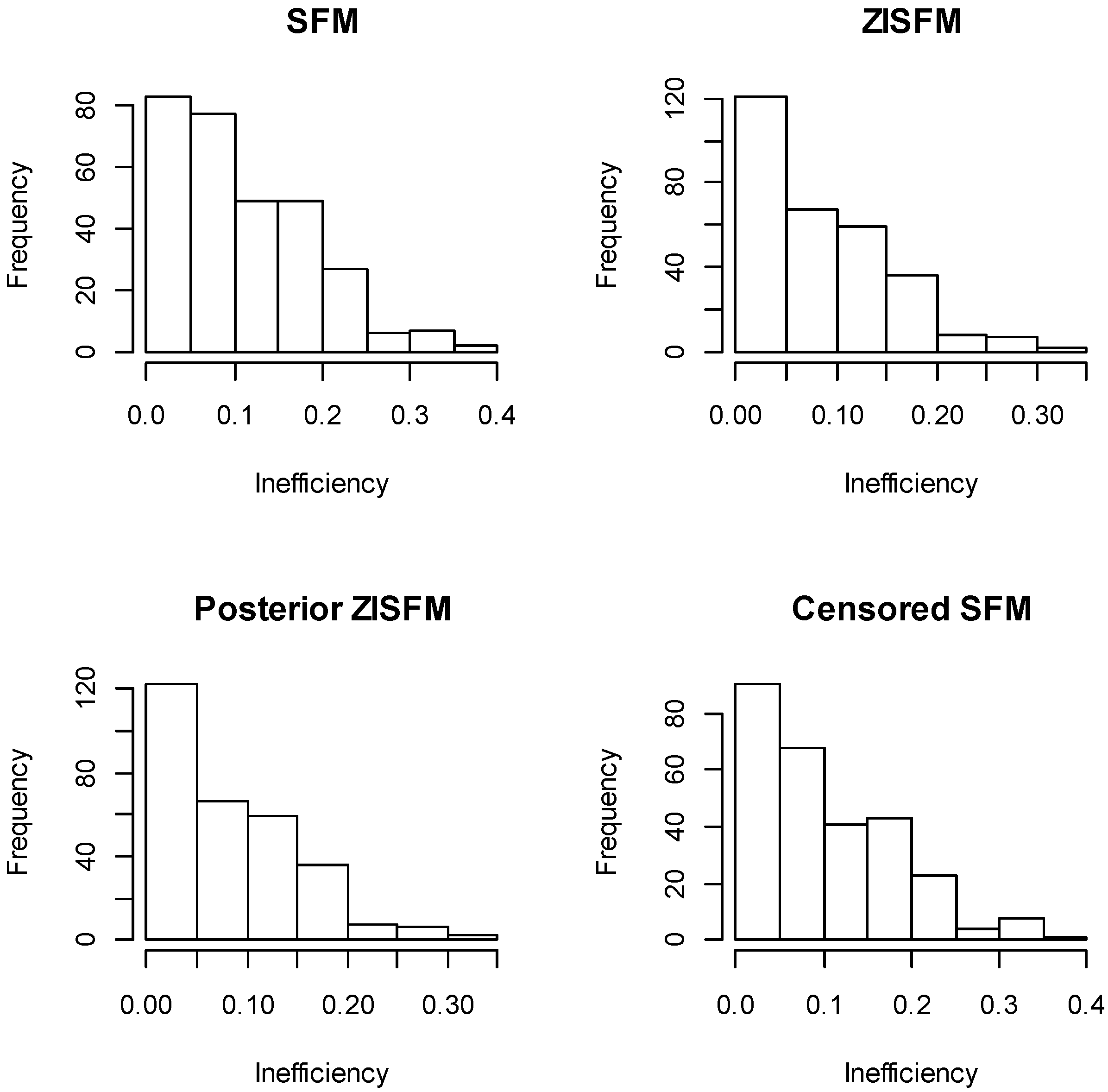

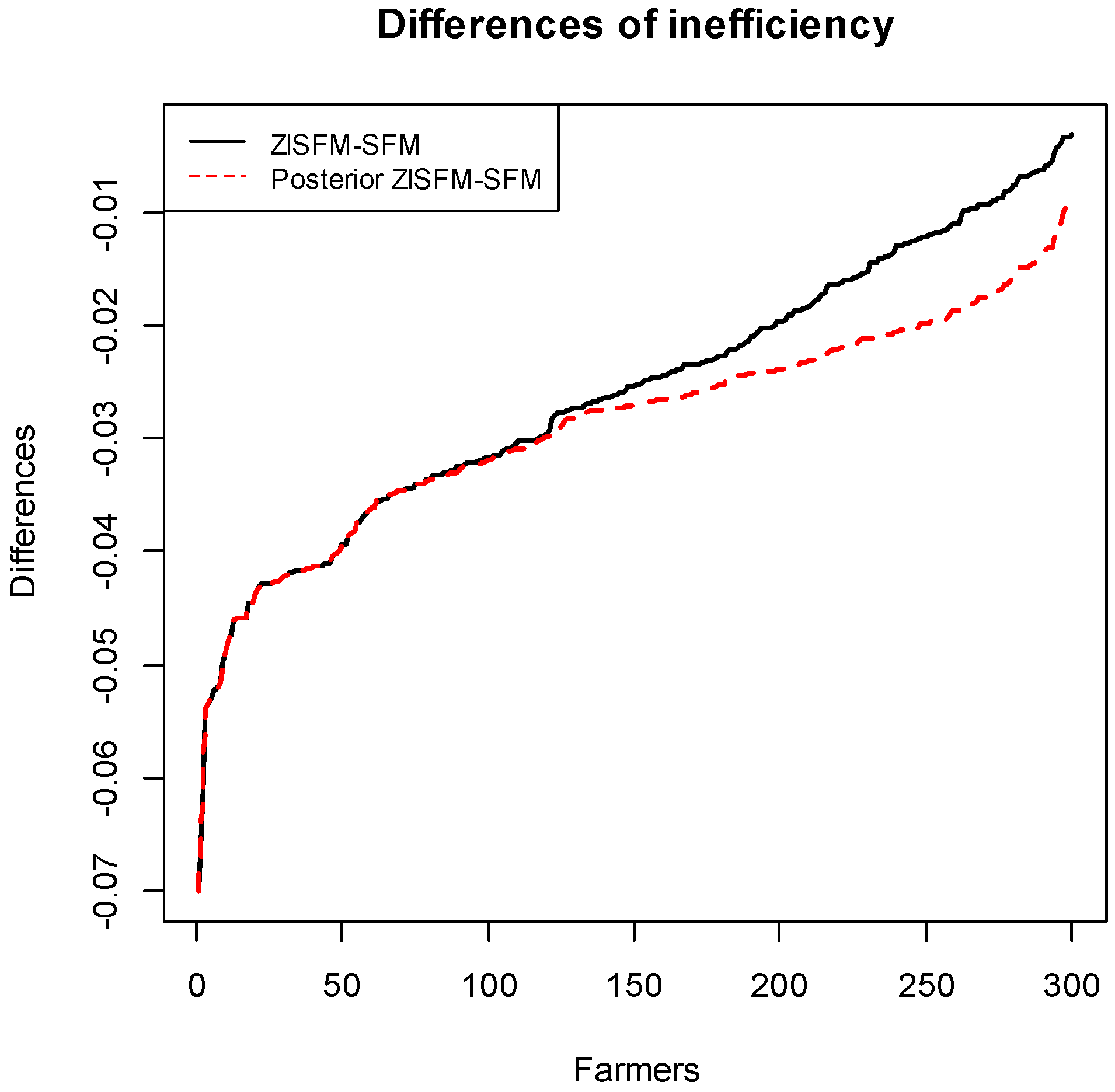

| Parameters | Traditional SFM | ZISFM | Censored SFM |
|---|---|---|---|
| Production Frontier | |||
| Constant | 10.3247 *** | 10.3298 *** | 10.3613 *** |
| (0.1256) | (0.1263) | (0.0295) | |
| ln Labor | 0.0927 ** | 0.0813 * | 0.1576 *** |
| (0.0401) | (0.0451) | (0.0249) | |
| ln Land | 0.6835 *** | 0.7096 *** | 0.6376 *** |
| (0.2125) | (0.2269) | (0.1071) | |
| ln Input | 0.2163 | 0.1965 | 0.2031 |
| (0.2047) | (0.2140) | (0.1301) | |
| ln Mechanical power | 0.0009 | 0.0048 | 0.0150 |
| (0.0336) | (0.0316) | (0.0214) | |
| ln Irrigation | −0.0228 | −0.0341 | −0.0439 *** |
| (0.0659) | (0.0654) | (0.0001) | |
| Slope | 0.0042 | 0.0037 | −0.0044 |
| (0.0189) | (0.0157) | (0.0322) | |
| Plain | 0.0318 | 0.0274 | 0.0276 |
| (0.0307) | (0.0258) | (0.0323) | |
| 0.5 × (ln Labor)2 | −0.6943 *** | −0.7098 *** | −0.6365 *** |
| (0.0875) | (0.0803) | (0.0644) | |
| 0.5 × (ln Land)2 | 1.7191 *** | 1.6421 *** | 1.5963 *** |
| (0.3579) | (0.3523) | (0.4124) | |
| 0.5 × (ln Input)2 | −0.1523 ** | −0.1566 ** | −0.0408 |
| (0.0731) | (0.0668) | (0.1049) | |
| 0.5 × (ln Mechanical power)2 | −0.0290 | −0.0294 | −0.0303 |
| (0.0232) | (0.0215) | (0.0256) | |
| 0.5 × (ln Irrigation)2 | −0.0031 | −0.0048 | −0.0061 *** |
| (0.0094) | (0.0094) | (0.0001) | |
| ln Labor × ln Land | −0.4590 * | −0.4208 * | −0.4246 *** |
| (0.2395) | (0.2277) | (0.1591) | |
| ln Labor × ln Input | 0.7230 *** | 0.6824 *** | 0.7195 *** |
| (0.2531) | (0.2405) | (0.1632) | |
| ln Labor × ln Mechanical power | 0.0726 * | 0.0766 * | 0.0049 |
| (0.0420) | (0.0407) | (0.0479) | |
| ln Labor × ln Irrigation | 0.0031 | 0.0029 | 0.0065 *** |
| (0.0021) | (0.0022) | (0.0019) | |
| ln Land × ln Input | −0.8664 *** | −0.8213 *** | −0.8659 *** |
| (0.1800) | (0.1787) | (0.2160) | |
| ln Land × ln Mechanical power | −0.8412 *** | −0.8903 *** | 0.4364 |
| (0.3207) | (0.2967) | (0.3203) | |
| ln Land × ln Irrigation | −0.0231 * | −0.0210 | −0.0203 ** |
| (0.0122) | (0.0138) | (0.0082) | |
| ln Input × ln Mechanical Power | 0.8722 *** | 0.9255 *** | 0.4608 |
| (0.3099) | (0.2879) | (0.3121) | |
| ln Input × Ln irrigation | 0.0202 * | 0.0184 | 0.0136 |
| (0.0118) | (0.0130) | (0.0094) | |
| ln Mechanical power × ln Irrigation | −0.0010 | −0.0009 | 0.0004 |
| (0.0022) | (0.0021) | (0.0014) | |
| Model diagnostics | |||
| p | --- | 0.1333 ** | --- |
| (0.0599) | |||
| σ2 | 0.0202 *** | 0.0195 | 0.0176 |
| (0.0033) | |||
| γ | 0.9563 *** | 0.9568 | 0.9992 |
| (0.0424) | |||
| σu | 0.1388 | 0.1365 *** | 0.1327 *** |
| (0.0032) | (0.0035) | ||
| σv | 0.0297 | 0.0290 *** | 0.0037 *** |
| (0.0015) | (0.0001) | ||
| λ | 4.6806 | 4.7097 | 12.7535 |
| PLR test | --- | 13.2333 *** | --- |
| Inefficiency effect | |||
| Educ1 | −0.0316 | −0.0252 | −0.0407 ** |
| (0.0227) | (0.0193) | (0.0177) | |
| Educ2 | −0.0381 | −0.0312 | 0.0507 ** |
| (0.0250) | (0.0212) | (0.0212) | |
| Educ3 | −0.0689 *** | −0.0542 *** | −0.0981 *** |
| (0.0236) | (0.0199) | (0.0213) | |
| Share of hired labor | 0.0111 | 0.0105 | −0.0131 |
| (0.0166) | (0.0142) | (0.0189) | |
| Planting pattern1 | 0.1959 *** | 0.1568 *** | 0.2164 *** |
| (0.0229) | (0.0195) | (0.0182) | |
| Planting pattern2 | 0.1299 *** | 0.0976 *** | 0.1502 *** |
| (0.0233) | (0.0198) | (0.0189) | |
| Planting pattern3 | 0.1012 *** | 0.0763 *** | 0.1157 *** |
| (0.0225) | (0.0191) | (0.0173) | |
| R2 | 0.7696 | 0.7412 | 0.7622 |
| Inefficiency | Min | Q25 | Median | Mean | Q75 | Max | SD |
| SFM | 0.0116 | 0.0439 | 0.0963 | 0.1121 | 0.1665 | 0.3709 | 0.0775 |
| ZISFM | 0.0084 | 0.0282 | 0.0673 | 0.0864 | 0.1331 | 0.3045 | 0.0657 |
| Posterior ZISFM | 0.0024 | 0.0207 | 0.0667 | 0.0835 | 0.1331 | 0.3045 | 0.0684 |
| Censored SFM | 0.0008 | 0.0597 | 0.0926 | 0.1188 | 0.1746 | 0.3757 | 0.0827 |
| Technical Efficiency | Min | Q25 | Median | Mean | Q75 | Max | SD |
| SFM | 0.6904 | 0.847 | 0.9086 | 0.8969 | 0.9574 | 0.9885 | 0.0673 |
| ZISFM | 0.7377 | 0.8756 | 0.9352 | 0.9194 | 0.9724 | 0.9917 | 0.0586 |
| Posterior ZISFM | 0.704 | 0.8579 | 0.9263 | 0.9112 | 0.9765 | 0.9972 | 0.0695 |
| Censored SFM | 0.6868 | 0.8398 | 0.9115 | 0.8910 | 0.9421 | 0.9991 | 0.06957 |
| Rank | SFM | TE | ZISFM | TE | Posterior ZISFM | TE |
|---|---|---|---|---|---|---|
| Farmer ID | Farmer ID | Farmer ID | ||||
| 1 | 38 | 0.9885 | 38 | 0.9917 | 38 | 0.9972 |
| 2 | 69 | 0.9875 | 69 | 0.9908 | 69 | 0.9967 |
| 3 | 58 | 0.9874 | 58 | 0.9907 | 58 | 0.9966 |
| 4 | 70 | 0.9867 | 70 | 0.9900 | 70 | 0.9961 |
| 5 | 34 | 0.9851 | 68 | 0.9893 | 68 | 0.9955 |
| … | … | … | … | … | … | … |
| 296 | 195 | 0.7315 | 195 | 0.7717 | 195 | 0.7415 |
| 297 | 173 | 0.7291 | 173 | 0.7681 | 173 | 0.7376 |
| 298 | 185 | 0.7137 | 185 | 0.7514 | 185 | 0.7191 |
| 299 | 178 | 0.6941 | 42 | 0.7403 | 42 | 0.7068 |
| 300 | 42 | 0.6904 | 178 | 0.7377 | 178 | 0.7040 |
| Total Sample | ZISFM (ton/ha) | Posterior ZISFM (ton/ha) |
| Stochastic frontier output | 7.7390 | 7.8146 |
| Actual output | 7.1234 | 7.1234 |
| Additional output | 0.6155 | 0.6912 |
| Increasing rate | 8.64% | 9.7% |
| Total additional output | 5,663,217 tons | 6,359,295 tons |
| Planting Pattern 1 | ZISFM | Posterior ZISFM |
| Stochastic frontier output | 7.3006 | 7.4450 |
| Actual output | 6.3890 | 6.3890 |
| Additional output | 0.9115 | 1.0560 |
| Increasing rate | 14.27% | 16.53% |
| Total additional output | 2,795,414 tons | 3,238,462 tons |
| Planting Pattern 2 | ZISFM | Posterior ZISFM |
| Stochastic frontier output | 7.8210 | 7.8810 |
| Actual output | 7.2843 | 7.2843 |
| Additional output | 0.5366 | 0.5966 |
| Increasing rate | 7.37% | 8.19% |
| Total additional output | 1,645,684 tons | 1,829,760 tons |
| Planting Pattern 3 | ZISFM | Posterior ZISFM |
| Stochastic frontier output | 8.0953 | 8.1178 |
| Actual output | 7.6968 | 7.6968 |
| Additional output | 0.3985 | 0.4210 |
| Increasing rate | 5.18% | 5.47% |
| Total additional output | 1,222,120 tons | 1,291,073 tons |
| ZISFM | Labor (Person Days) | Land (m2) | Material Inputs (Baht) | Mechanical Power (Baht) |
| Efficient farmers | 0.5671 | 1267.52 | 3570.936 | 3662.076 |
| (N1 = 40, 13%) | ||||
| Inefficient farmers | 0.7040 | 1439.52 | 4033.14 | 4009.931 |
| (N2 = 260, 87%) | ||||
| Resource saving per ton | 0.1369 | 172.00 | 462.2044 | 347.8546 |
| Resource saving % | 19.44% | 11.95% | 11.46% | 8.67% |
| Total saving in Thailand | 2,978,334 | 3,741,513,600 | 10,052,945,485 | 7,565,837,280 |
| Posterior ZISFM | ||||
| Efficient farmers | 0.5637 | 1236.00 | 3390.375 | 3452.244 |
| (N1 = 22, 7% of total) | ||||
| Inefficient farmers | 0.6939 | 1429.44 | 4014.93 | 4003.066 |
| (N2 = 278, 93% of total) | ||||
| Resource saving per ton | 0.1301 | 193.44 | 624.5557 | 550.8216 |
| Resource saving % | 18.75% | 13.53% | 15.55% | 13.76% |
| Total saving in Thailand | 3,026,106 | 4,499,564,800 | 14,520,920,054 | 12,806,601,503 |
© 2017 by the authors. Licensee MDPI, Basel, Switzerland. This article is an open access article distributed under the terms and conditions of the Creative Commons Attribution (CC BY) license (http://creativecommons.org/licenses/by/4.0/).
Share and Cite
Liu, J.; Rahman, S.; Sriboonchitta, S.; Wiboonpongse, A. Enhancing Productivity and Resource Conservation by Eliminating Inefficiency of Thai Rice Farmers: A Zero Inefficiency Stochastic Frontier Approach. Sustainability 2017, 9, 770. https://doi.org/10.3390/su9050770
Liu J, Rahman S, Sriboonchitta S, Wiboonpongse A. Enhancing Productivity and Resource Conservation by Eliminating Inefficiency of Thai Rice Farmers: A Zero Inefficiency Stochastic Frontier Approach. Sustainability. 2017; 9(5):770. https://doi.org/10.3390/su9050770
Chicago/Turabian StyleLiu, Jianxu, Sanzidur Rahman, Songsak Sriboonchitta, and Aree Wiboonpongse. 2017. "Enhancing Productivity and Resource Conservation by Eliminating Inefficiency of Thai Rice Farmers: A Zero Inefficiency Stochastic Frontier Approach" Sustainability 9, no. 5: 770. https://doi.org/10.3390/su9050770







